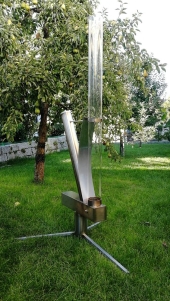I would like to emphasize that there is a chemical difference between biochar and *most* charcoal, because most charcoal is prepared in a way that preserves a lot of the volatile components in order to keep the energy content high (i.e., if you're making charcoal to burn, you typically want it to have a high energy content, and you do that by minimizing the loss of volatile components). Biochar, on the other hand, is produced with the goal of burning off all of those volatile components.
Why is this important? It's important because a lot of those volatile components are soil contaminants that you don't want around your food. It's almost like having soil contaminated with diesel fuel. That's why most folks in the biochar field recommend against buying sacks of lump charcoal from the store and grinding it up to put in your garden -- you'd be amending your soil with some pretty ugly (and persistent) chemicals. Some of those compounds can be broken down by soil bacteria, but it's a.very.slow.process. So, they can do a good job on the trace amounts commonly found in biochar, but have a more difficult time handling the amount present in charcoal intended for burning.
(Note that the one exception re: charcoal is charcoal meant for things like smithing, which (like biochar) is made with the goal of burning off all the volatile components, to yield a high purity carbon source.)









